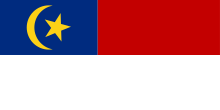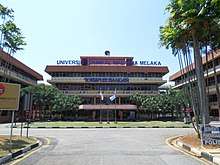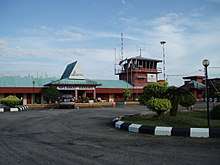Malacca
Malacca (Malay: Melaka; Tamil: மலாக்கா; Chinese: 馬六甲; pinyin: Mǎliùjiǎ; dubbed "The Historic State",[14] is a state in Malaysia located in the southern region of the Malay Peninsula, next to the Strait of Malacca.
Malacca Melaka | |
|---|---|
| Malacca State | |
| Other transcription(s) | |
| • Malay | Melaka (Rumi) ملاک (Jawi) |
| • Chinese | 马六甲 (Simplified) 馬六甲 (Traditional) |
| • Tamil | மலாக்கா |
| Nickname(s): The Venice of the East[1] | |
| Motto(s): "Bersatu Teguh" (Firmly United) | |
| Anthem: Melaka Maju Jaya | |
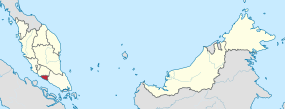 | |
| Coordinates: 2°12′N 102°15′E | |
| Capital | Malacca City |
| Government | |
| • Type | Parliamentary |
| • Yang di-Pertua Negeri | Ali Rustam |
| • Chief Minister | Sulaiman Md Ali (PN-UMNO) |
| Area | |
| • Total | 1,664 km2 (642 sq mi) |
| Population (2015)[3] | |
| • Total | 872,900 |
| Demonym(s) | Malaccan |
| HDI | |
| • 2010 | 0.804 (very high) (4th) |
| Postal code | 75xxx to 78xxx |
| Calling code | 06 |
| Vehicle registration | M |
| Malacca Sultanate | 15th century |
| Portuguese control[4] | 24 August 1511 |
| Dutch control[5][6] | 14 January 1641 |
| British control[5][6][7][8] | 17 March 1824 |
| Japanese occupation[9][10] | 11 January 1942 |
| Accession into the Malayan Union[11] | 1 April 1946 |
| Accession into the Federation of Malaya[12] | 1 February 1948 |
| Independence as part of the Federation of Malaya[13] | 31 August 1957 |
| Website | www |
The state is bordered by Negeri Sembilan to the north and west and Johor to the south. The exclave of Cape Rachado also borders Negeri Sembilan to the north. Its capital is Malacca City, which is 148 kilometres (92 miles) southeast of Malaysia's capital city Kuala Lumpur, 235 kilometres (146 miles) northwest of Johor's largest city Johor Bahru and 95 km (59 miles) northwest of Johor's second largest city, Batu Pahat. This historical city centre has been listed as a UNESCO World Heritage Site since 7 July 2008.[15]
Although it was the location of one of the earliest Malay sultanates, the local monarchy was abolished when the Portuguese conquered it in 1511. The head of state is the Yang di-Pertua Negeri or Governor, rather than a Sultan. Melaka is famous for its unique history and is one of the major tourist destinations in Malaysia. With a highly strategic state position for international trade routes, Malacca was once a well-known international trade centre in the East. Many traders anchored in Malacca, especially traders from Arabia, China and India, traded at the port of Malacca and from there were born many of the descendants and tribes that exist in Malacca to this day.
The harmonious life and ambience of the people of Malacca is attributed to the life of various races and ethnicities that have long existed among the local community. Malays, Malaysian Chinese, Malaysian Indians, Baba Nyonya, Kristang, Chitty and Eurasians are important ethnic groups living in the State of Malacca up to the present day.[16][17][18][19][20]
History
| History of colonial Malacca | |
|---|---|
| Periods: | |
Portuguese Malacca (1511-1641) | |
Dutch VOC (1641-1824) | |
British Straits Settlements (1824-1948) | |
| See also: | |
| Sultanate of Malacca | |
| Fall of Malacca 1511 | |
| Sultanate of Johor | |
| The Battle of Cape Rachado 1606 | |
| The Battle of Malacca 1641 | |
Sultanate of Malacca
Before the arrival of the first Sultan, Malacca was a fishing village inhabited by local inhabitants known as Orang Laut. Malacca was founded by Parameswara, also known as Iskandar Shah. He found his way to Malacca around 1402 where he found a good port—it was accessible in all seasons and on the strategically located narrowest point of the Malacca Straits.[21] In 1403, the first official Chinese trade envoy led by Admiral Yin Qing arrived in Malacca. Later, Parameśwara was escorted by Zheng He and other envoys in his successful visits. Malacca's relationships with Ming China granted it protection from attacks by Siam and Majapahit. Malacca officially submitted to Ming China as a protectorate. This encouraged the development of Malacca into a major trade settlement on the trade route between China and India, Middle East, Africa and Europe.[22]
According to a popular legend, Parameswara was resting under a tree near a river during a hunt, when one of his dogs cornered a mouse deer. In self-defence, the mouse deer pushed the dog into the river. Impressed by the courage of the deer, and taking it as a propitious omen of the weak overcoming the powerful, Parameswara decided then and there to found an empire on that very spot. He named it 'Malacca' after the tree where he had just taken shelter at, the Malacca tree (Malay: Pokok Melaka).[23]
Winstedt[24] suggested that the mouse deer story is likely a story modified from a folk-tale from Kandy, Sri Lanka. And more recently, Ahmat Adam[25] pointed out the another possible source of the mouse deer story in his recent romanization work on Hikayat Raja-Raja Pasai. Since the founding of Kandy and Pasai predate Melaka, it is not unsafe to conclude that the Melaka version of mouse deer is borrowed and adapted from them.
In collaboration with allies from the sea-people (orang laut), the wandering proto-Malay privateers of the Straits, he established Malacca as an international port by compelling passing ships to call there, and establishing fair and reliable facilities for warehousing and trade.[21]

In Malacca during the early 15th century, Ming China actively sought to develop a commercial hub and a base of operation for their treasure voyages into the Indian Ocean.[26] Malacca had been a relatively insignificant region, not even qualifying as a polity prior to the voyages according to both Ma Huan and Fei Xin, and was a vassal region of Siam.[26] In 1405, the Ming court dispatched Admiral Zheng He with a stone tablet enfeoffing the Western Mountain of Malacca as well as an imperial order elevating the status of the port to a country.[26] The Chinese also established a government depot (官廠) as a fortified cantonment for their soldiers.[26] Ma Huan reported that Siam did not dare to invade Malacca thereafter.[26] The rulers of Malacca, such as Parameswara in 1411, would pay tribute to the Chinese emperor in person.[26] In 1431, when a Malaccan representative complained that Siam was obstructing tribute missions to the Ming court, the Xuande Emperor dispatched Zheng He carrying a threatening message for the Siamese king saying "You, king should respect my orders, develop good relations with your neighbours, examine and instruct your subordinates and not act recklessly or aggressively."[26] The early kings of Malacca—Parameswara, Megat Iskandar Shah, and Sri Maharaja—understood that they could gain Ming China's protection through skilful diplomacy and thereby could establish a strong foundation to their kingdom against Siam and other potential enemies.[27] Chinese involvement was crucial for Malacca to grow into a key alternative to other important and established ports.[28]
To enhance relations, Hang Li Po, according to local folklore, a daughter of the Ming Emperor of China, arrived in Malacca, accompanied by 500 attendants, to marry Sultan Manshur Shah who reigned from 1456 until 1477. Her attendants married locals and settled mostly in Bukit Cina.[29]
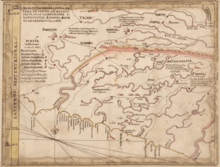
"In the 9th month of the year 1481 envoys arrived with the [......] Malacca again sent envoys to China in 1481 to inform the Chinese that, while Malaccan envoys were returning to Malacca from China in 1469, the Vietnamese attacked the Malaccans, killing some of them while castrating the young and enslaving them. The Malaccans reported that Vietnam was in control of Champa and also sought to conquer Malacca, but the Malaccans did not fight back, because they did not want to fight against another state that was a tributary to China without permission from the Chinese. They requested to confront the Vietnamese delegation to China which was in China at the time, but the Chinese informed them since the incident was years old, they could do nothing about it, and the Emperor sent a letter to the Vietnamese ruler reproaching him for the incident. The Chinese Emperor also ordered the Malaccans to raise soldiers and fight back with violent force if the Vietnamese attacked them again.[30][31]
Colonial era

In April 1511, Alfonso de Albuquerque set sail from Goa to Malacca with a force of some 1200 men and seventeen or eighteen ships.[32] They conquered the city on 24 August 1511. After seizing the city Afonso de Albuquerque spared the Hindu, Chinese and Burmese inhabitants but had the Muslim inhabitants massacred or sold into slavery.[4]
It soon became clear that Portuguese control of Malacca did not also mean they controlled Asian trade centred there. Their Malaccan rule was severely hampered by administrative and economic difficulties.[33] Rather than achieving their ambition of dominating Asian trade, the Portuguese had disrupted the organisation of the network. The centralised port of exchange of Asian wealth had now gone, as was a Malay state to police the Straits of Malacca that made it safe for commercial traffic. Trade was now scattered over a number of ports among bitter warfare in the Straits.[33]
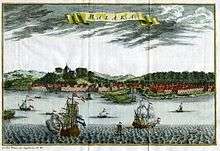
The Jesuit missionary Francis Xavier spent several months in Malacca in 1545, 1546, and 1549. The Dutch launched several attacks on the Portuguese colony during the first four decades of the seventeenth century. The first attack took place in 1606 under the command of Dutch Admiral Cornelis Matelief de Jonge who laid siege to the town with the help of his Johor allies. He engaged the Portuguese armada which had been sent from Goa to offer armed relief to the besieged port.[34] On 14 January 1641, the Dutch defeated the Portuguese in an effort to capture Malacca, with the help of the Sultan of Johor.[5][6][35] The Dutch ruled Malacca from 1641 to 1798 but they were not interested in developing it as a trading centre, placing greater importance on Batavia (Jakarta) and Java as their administrative centre. However they still built their landmark, better known as the Stadthuys. In the Dutch era the building was white, the red paint is of later date.
_(14580981259).jpg)
Malacca was ceded to the British in the Anglo-Dutch Treaty of 1824 in exchange for Bencoolen on Sumatra. From 1824 to 1942, Malacca was under the rule of the British, first by the British East India Company and then as a crown colony. Due to dissatisfaction with British jurisdiction over Naning, Dol Said, a local chief, fought the East India Company in a war from 1831 to 1832, which resulted in a decisive British victory. It formed part of the Straits Settlements, together with Singapore and Penang. Malacca went briefly under the rule of Empire of Japan in 1942–1945[36] during World War II.
Post colonial era
After the dissolution of this crown colony, Malacca and Penang became part of the Malayan Union on 1 April 1946,[11] which later became the Federation of Malaya on 1 February 1948.[12] The declaration of independence was made by the first Prime Minister of Malaya, Tunku Abdul Rahman, at Padang Pahlawan on 20 February 1956, which eventually led to the independence of Malaya on 31 August 1957.[13] On 16 September 1963, Malaysia was formed with the merger of Malaya with Sabah, Sarawak and Singapore, and Malacca became part of it.[37] On 15 April 1989, Malacca was declared a historical city. It was then also listed as UNESCO World Heritage Site since 7 July 2008.[15]
Geography
The state of Malacca covers an area of 1,664 km2 (642 sq mi).[2] It sits upon the southwestern coast of the Malay Peninsula opposite Sumatra, with the state of Negeri Sembilan to the north and west and Johor to the east. Malacca is situated roughly two-thirds of the way down the west coast, 148 km (92 mi) south of Kuala Lumpur and commands a central position on the Straits of Malacca. With the exception of some of its small hills, Malacca is generally a lowland area with average elevation below 50 meters above sea level.[38]
The Malacca River roughly runs through the centre line of the state from north to south. Kesang River acts as the eastern border of Melaka with Johor. The offshore Besar Island, Upeh Island and Undan Island are part of Malacca which are accessible by jetty from Malacca mainland. The peninsula of Tanjung Tuan (Cape Rachado) is an exclave of the state, situated on the coast of Negeri Sembilan which it borders to the north. Malacca has several beaches edged with palm trees which has brought a number of resorts along the coast. Beaches include Tanjung Bidara Beach, Klebang Beach, Puteri Beach and Pengkalan Balak Beach.[39]
The man-made Malacca Island is connected to the mainland and it is the first phase of the development of Malacca Gateway offshore development, expected to be completed by 2025.
Climate
The climate of Malacca is hot and humid throughout the year with rainfall occurring mostly between October and March. Temperature ranges generally between 30-35 °C during daytime and between 27-29 °C during night time.[40]
| Climate data for Malacca (1961–1990) | |||||||||||||
|---|---|---|---|---|---|---|---|---|---|---|---|---|---|
| Month | Jan | Feb | Mar | Apr | May | Jun | Jul | Aug | Sep | Oct | Nov | Dec | Year |
| Average high °C (°F) | 31.4 (88.5) |
32.6 (90.7) |
32.6 (90.7) |
32.4 (90.3) |
31.8 (89.2) |
31.4 (88.5) |
31.0 (87.8) |
30.9 (87.6) |
31.0 (87.8) |
31.3 (88.3) |
31.0 (87.8) |
30.9 (87.6) |
31.5 (88.7) |
| Average low °C (°F) | 22.5 (72.5) |
22.9 (73.2) |
23.1 (73.6) |
23.4 (74.1) |
23.4 (74.1) |
23.0 (73.4) |
22.7 (72.9) |
22.7 (72.9) |
22.7 (72.9) |
22.9 (73.2) |
22.9 (73.2) |
22.6 (72.7) |
22.9 (73.2) |
| Average rainfall mm (inches) | 73.3 (2.89) |
90.9 (3.58) |
144.1 (5.67) |
197.5 (7.78) |
172.0 (6.77) |
165.8 (6.53) |
164.2 (6.46) |
164.1 (6.46) |
210.2 (8.28) |
212.9 (8.38) |
231.5 (9.11) |
123.8 (4.87) |
1,950.3 (76.78) |
| Average rainy days (≥ 1.0 mm) | 7 | 7 | 10 | 13 | 12 | 10 | 12 | 12 | 13 | 14 | 17 | 11 | 138 |
| Mean monthly sunshine hours | 193.0 | 202.5 | 214.8 | 207.5 | 210.5 | 193.9 | 201.3 | 191.2 | 171.5 | 179.6 | 156.9 | 166.8 | 2,289.5 |
| Source: NOAA[41] | |||||||||||||
Government
 | |||||
| Affiliation | Coalition/Party Leader | Status | Seats | ||
|---|---|---|---|---|---|
| 2018 election | Current | ||||
| Perikatan Nasional | Sulaiman Md Ali | Government | 13 | 17 | |
| Pakatan Harapan | Adly Zahari | Opposition | 15 | 11 | |
| Government majority | 2 | 6 | |||

Malacca's state parliament is called the State Legislative Assembly and the party in power forms the Executive Committee. The assembly represents the highest authority in the state and decides on policy matters. The State Executive Council is responsible to the assembly and comprises members who are appointed every five years by the political party in power. It is headed by the Yang di-Pertua Negeri who is appointed by the Yang di-Pertuan Agong of Malaysia. The current Yang di-Pertua Negeri is Mohd Khalil Yaakob.
The State Government is headed by the Chief Minister. The minister is appointed by Yang di-Pertua Negeri from among the State Legislative Assembly members. The Chief Minister presides over a meeting of State Executive Council ministers weekly at the Chief Minister's office. The Chief Minister's Department is responsible for the overall administration of the state, as well as its political interest. The current Chief Minister is Sulaiman Md Ali from the UMNO.
The administrative complex is located at Seri Negeri complex in Ayer Keroh. It houses the Chief Minister's office, State Legislative Assembly and State Secretariat office. For administrative purposes, Malacca is divided into three districts under separate jurisdiction:
- Malacca Central District and Land Office
- Alor Gajah District and Land Office
- Jasin District and Land Office
Districts and local authorities
Malacca is divided into 3 districts and 4 local authorities.
| Rank | District | Area (km2) | Population (2010)[42] | District Seat | Local Government |
|---|---|---|---|---|---|
| 1 | Central Malacca | 279.85 | 503,127 | Malacca City Ayer Keroh |
Historical Malacca City Council Hang Tuah Jaya Municipal Council |
| 2 | Alor Gajah | 660.00 | 182,666 | Alor Gajah Town | Alor Gajah Municipal Council |
| 3 | Jasin | 676.07 | 135,317 | Jasin Town | Jasin Municipal Council |
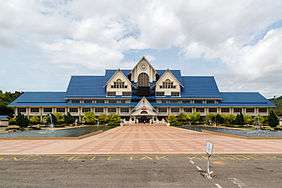
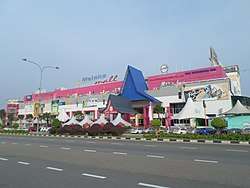
Towns
Besides Malacca City, other major Malacca townships include Alor Gajah, Asahan, Ayer Keroh, Batang Melaka, Batu Berendam, Bemban, Bukit Katil, Cheng, Durian Tunggal, Hang Tuah Jaya, Jasin, Klebang, Kuala Sungai Baru, Lendu, Lubuk China, Machap Baru, Malacca Pindah, Masjid Tanah, Merlimau, Naning, Nyalas, Pulau Sebang, Ramuan China, Selandar, Serkam, Simpang Ampat, Sungai Rambai, Sungai Udang, Tanjung Kling, Telok Mas and Umbai.
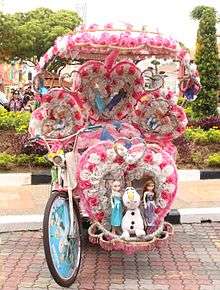
Economy
Despite being located in a land without any significant natural resources, the economy of Malacca dates back more than 500 years, due to its strategic location. As the center of the all important spice trade, Malacca attracted many colonial powers to engage wars to control it.[43]
Sungai Udang houses the PETRONAS Malacca Refinery Complex consisting two refining trains, established in 1994 and 1999 and owned by PETRONAS Penapisan (Melaka) Sdn. Bhd. and Malaysian Refining Company Sdn. Bhd. respectively. The total capacity of the refinery is 270,000 barrels of oil per day.[44][45]
The Malacca International Trade Centre in Ayer Keroh which was opened in June 2003 is the leading commercial centre and the centre for meetings, incentives, convention and exhibitions which plays an important role in the development of trade in Malacca.[46]
On 20 October 2010 an event was held to announce that Malacca had met the benchmark of 'Developed State' as set out by the Organisation for Economic Co-operation and Development and a declaration of "Melaka Maju 2010" was made.[47][48]
As of 2012, service sector contributes to the largest share of economy in Malacca accounted for 46.9%, followed by manufacturing (43.5%), agriculture (6.5%), construction (2.9%) and mining (0.1%).[49] In terms of number of workforce, as of 2013, there were 275,000 people working in the industrial sectors, 225,000 people working in the service sectors, 35,000 people working in the entrepreneurship sectors and 12,300 people working in the agricultural sectors.[50]
Malacca has successfully opened itself up to foreign investors since the early 1970s. By 1997, the state has registered a total investment of over MYR16 billion. In 2014, the state achieved a total MYR4.4 billion worth of investment, in which MYR1.8 billion came from foreign investors.[51]
In 2013, Malacca had a GDP of MYR22,646 million with GDP per capita of MYR34,109. It had 3.2% GDP growth in 2013. Inflation rate in 2012 was 1.6%. As of 2015, the Malacca State Government has an outstanding MYR861.7 million of loan to the federal government. In 2014, the state government's reserve amounted to MYR206.61 million.[52] The unemployment rate in 2014 was 0.9% or around 3,500 people.[53] The state has a relatively well-educated population, with a youth literacy rate of 99.5% as reported by Malaysia Millennium Development Goals Report 2015.[54]
Currently there are 23 industrial areas which are centred along the edges of the city proper in suburbs which include Ayer Keroh, Batu Berendam, Cheng, Taman Tasik Utama and Tanjung Kling. While outside Malacca City, industrial areas include Alor Gajah and Sungai Udang. There are around 500 factories in the state which come from Germany, Japan, Singapore, Taiwan, United States etc. For small and medium-sized enterprises, a number of estates have been established by the state government.[55][56]
In 2016, Malacca became the safest place to live in Malaysia.[57] The state crime rates dropped by 15.5 per cent in 2017 with 3,096 cases recorded compared to 3,663 in 2016.[58] Malacca recorded a gross domestic product (GDP) growth of 8.1% in 2017, the second highest in the country after Sabah. Services sector remained the main contributor to the state’s economy at 44.8% of GDP. The GDP per capita also expanded 11.2% to RM46,015 in 2017, surpassing the national-level figure of RM42,228.[59] The State Socioeconomic Report 2017 published on July 26, 2018 reported that Malacca was the state that recorded the lowest unemployment rate in 2017 with only 1.0 percent.[60][61]
Culture
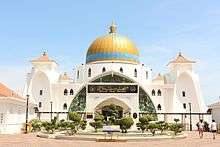
Each group upholds their tradition and it is reflected in their food, religion customs, festivals, culture, design, application, jewellery and handicrafts.[62] Among the unique Melaka culture is Dondang Sayang which is recognized by UNESCO. Dondang Sayang is a traditional Malay art still practised in Melaka by four communities: the Malay, Baba Nyonya, Chitty and Portuguese communities. The practice combines elements of music (violins, gongs and tambourines or the tambour), songs and chants, and features melodious strains of poetry. Also known as love ballads, the songs are used by communities to convey feelings of love and give advice on special topics such as love and kindness.[63][64] Melaka is very famous for its unique food products such as belacan, cincalok, dodol, gula Melaka and others.[65] For food, Malacca received recognition from the World Street Food Congress for Nyonya Siamese Noodles (34th) and Coolie Street Satay (43rd).[66] The various street dishes and delicacies of Malacca include (but not limited to) satay celup; chicken rice balls; duck noodles; Melaka-style wantan mee; nyonya laksa; pai tee (also known as pie tee and top hats); ayam pongteh; asam pedas with fish; Portuguese grilled fish and seafood; fishball lobak; coconut shake; nyonya cendol; putu piring; and nyonya kuih.[67]
Demographics
Malacca has an estimated population of 931,210 as of 2016 with an average annual population growth of 2%.[53][68] As of 2016, 27% of the population aged below 15 years old and 8% aged above 60 years old.[50] The ethnic composition of Malacca as of 2015 is 66.8% Malays (552,700), 1.4% other Bumiputras (11,500), 26.0% Chinese (215,000), 6.2% Indians and Chitty (51,400) and 0.6% others (4,800).[3] Malacca has small communities of Kristang, Dutch Eurasian and Temuan people.
Malay community in Malacca is generally divided into two, which are the Temenggong custom and the Perpatih custom.[69] The remaining traditional Malay village in Malacca City is the Morten Village.[70]
Jonker Walk is the Chinatown area of Malacca. It was once known for its antique shops but have since turned into a well-known tourist destination that features clothes, food and crafts.[71] The Peranakan people in Malacca show unique features, such as furniture, porcelain, crockery, style and food. Their culture is showcased at the Baba Nyonya Heritage Museum.
Indians in Malacca are predominantly Tamils, many of whom used to work at the rubber plantation.[72] However, many of them now work in the jewellery, fabrics, retailers, merchants and money lender sectors.[73] Many of them reside in Little India. There is also Chitty Village for the minority Chitty people which houses the Chitty Museum.
Besides, small number of Malayalees who speak Malayalam and Telugus who speak Telugu exist among the Indians in Malacca. Malacca Kerala Samajam is an association that represents the Malayalam speaking community in Malacca. A branch of Telugu Association Malaysia is situated in Ayer Keroh to represent the Telugu speaking community in Malacca.
A sizeable number of Punjabi Sikhs residing in Malacca, and Sikhs from Malacca and abroad congregate in the gurdwara (Sikh temple) situated in Jalan Temenggong.[74] They celebrate the Guru Nanak's birthday and Vasakhi new year annually.
A population of Portuguese descent, who speak a Portuguese creole, are the descendants of colonists from the 16th and 17th centuries.[75] Even to this day, many of the traditions originating with the Portuguese occupation are still practised, i.e. "Intrudu" from Portuguese word "Entrudo" (a water festival that marks the beginning of Lent, the Catholic fasting period), "branyu" (traditional dance), "Santa Cruz" (a yearly Festival of street celebrations). Many of them settle down around the Portuguese Settlement area, which has a population of about 1,200 residents.[76]
The indigenous people, mostly ethnic Temuan is relatively small. They generally reside in rural settlements, the edge of the woods and along the coast facing Malacca Strait. Malacca houses the Aborigines Museum in Ayer Keroh.[62]
Language
Malacca is a multi-linguistic state. Malaysian is the official language of Malacca and is used in the government and public sectors. English is widely used in the business and tourism sectors. A local Malay, known as Malaccan Malay is a unique variety of Malay spoken within the state of Malacca. It has its own distinct pronunciation and vocabulary compared to the rest of Malaysia. Other minority languages such as Chinese and its varieties, Tamil, Malayalam, Telugu, Punjabi, Kristang (Portuguese creole) and various Malay-based creoles such as Baba Malay and Malaccan Creole Malay are also spoken.[77] The Orang Asli languages spoken within Malacca are mostly speakers of the Temuan language.
Religion
According to the 2010 census, the population of Malacca is 66.1% Muslim, 24.2% Buddhist, 5.7% Hindu, 3.0% Christian, 0.4% of unknown affiliation, 0.2% non-religious, 0.2% Taoist or Chinese religion follower, and 0.2% of followers of other religions.[78]
Statistics from the 2010 Census indicate that 91.6% of the Chinese population in Malacca are identified as Buddhists, with significant minorities of adherents identifying as Christians (6.7%), Chinese folk religions (0.7%) and Muslims (0.4%). The majority of the Indian population are Hindus (86.3%), with a significant minorities of numbers identifying as Christians (6.6%), Muslims (3.4%) and Buddhists (2.8%). The non-Malay bumiputera community are predominantly Christians (46.8%), with significant minorities identifying as Muslims (24.2%) and Buddhists (12.0%).[79]
As the definition of a "Malay" in the Malaysian constitution requires that the person professes the religion of Islam, all Malays are necessarily Muslims.[79][80]
Sports
Sports-related affairs of Malacca are governed by the Malacca State Sports Council (Malay: Majlis Sukan Negeri Melaka) under the Malacca State Government.[81] Another governing body of sports in Malacca is the Department of Youth and Sports (Malay: Jabatan Belia dan Sukan Negeri Melaka).
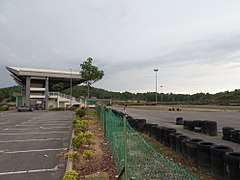
Malacca is home to several football stadiums, such as Hang Jebat Stadium, Hang Tuah Stadium and Tun Fatimah Stadium. Built in 1954, Hang Tuah Stadium is the oldest stadium in Malacca.[82] Established under the Malacca Stadium Corporation Enactment of 2004, the Malacca Stadium Corporation is the entity that manages stadiums in Malacca which started its operation on 16 September 2004.[83]
There is also a motorsport racetrack in Ayer Keroh, the Malacca International Motorsport Circuit. Ayer Keroh also houses the Malacca International Bowling Centre. With 52 lanes, it is the largest bowling centre in Malaysia.[84]
There are four golf courses in Malacca, namely Ayer Keroh Golf and Country Club, Orna Golf and Country Club and Tiara Malacca Golf and Country Club in Ayer Keroh and A'Famosa Golf Resort in Simpang Ampat.[85] Golf-related paraphernalia in Malacca is showcased at the Malacca Golf Gallery.
Malacca was the host venue for the 2010 Sukma Games held on 10–19 June 2010.
Malacca also has a football team known as Melaka United representing Malacca in the Malaysian football league. The Melaka football team won the first Malaysia Premier League title in 1983, in addition they were the champion of the third division of the Malaysia football league, FAM League Cup, in 2015 before won the second Premier League title a year after it. Melaka United uses the Hang Jebat Stadium in Krubong as their home ground with a capacity of 40,000 spectators.
Education
Primary and secondary education
Up to 2018, there are 237 primary schools and 77 secondary schools in Melaka.[86] Sekolah Jenis Kebangsaan (C) Yok Bin, Sekolah Kebangsaan Convent Of The Infant Jesus (2), Sekolah Kebangsaan (P) Methodist (2) and Sekolah Kebangsaan Convent Of The Infant Jesus (1) is the high performance primary school in Melaka while for secondary school is Sekolah Menengah Sains Muzaffar Syah (MOZAC), Sekolah Berasrama Penuh Integrasi Selandar and Sekolah Menengah Kebangsaan Agama Sharifah Rodziah.[87] The Malacca High School is one of the premier schools in Malaysia and is the second oldest recorded school in the country after Penang Free School in Penang. The Ministry of Education of Malaysia enrolls students based on their Ujian Penilaian Sekolah Rendah (UPSR) and Pentaksiran Tingkatan 3 (PT3). A centre for juvenile convicts, Henry Gurney Prisoners School, is in Telok Mas, Malacca. Established in 1949 as High Moral School, it was renamed to the School of Henry Gurney on May 15, 1950. This centre runs rehabilitation programs for male juvenile offenders.
Malacca has three international schools, the Melaka International School, which cater for the local communities; MES and KYS International School, staffed by expatriate teachers, which specialise in teaching Cambridge International A Levels and cater for the expatriate communities.
Higher education
Institutions include:
- Universiti Teknikal Malaysia Melaka (UTeM).
- Universiti Teknologi MARA (UiTM) campuses that are located at Lendu, Malacca City and Jasin.
- Malacca Manipal Medical College in Bukit Baru is the foremost institution for medical education in the state.
- Multimedia University (MMU) at Bukit Beruang.
- Malaysian Maritime Academy (ALAM) at Kuala Sungai Baru.
- Malaysian Han Studies (MAHANS) at Hang Tuah Jaya.
There are several institutions that offer nursing education: Institut Kesihatan Sains & Kejururawatan Pantai, Institut Sains Kesihatan Dan Kejururawatan Mahkota, Kolej Kejururawatan & Kesihatan Nilam, and Kolej Perubatan Komplementari Melaka. Institut Kesihatan Sains & Kejururawatan Pantai is linked to Pantai Hospital at Ayer keroh while Institut Sains Kesihatan Dan Kejururawatan Mahkota is linked to Mahkota Medical Centre.
The Institut Skill Tech in Machap provides training in agriculture. It has a branch in Taman Tasik Utama, Ayer Keroh.
Part-time study is available at Open University Malaysia (OUM), while those who wish to obtain an academic diploma can enroll at University of Malaya Centre for Continuing Education (UMCCE) at Sinar College.
Association of Chartered Certified Accountants (ACCA) lectures and examinations are provided at Sinar College at Malacca City. Sinar College is the only institution in the state that offers complete accounting education. Sinar College is the only approved training centre for tourism courses. Other academic institutions include International College of Yayasan Melaka (ICYM), Melaka International College of Science and Technology (MiCoST).
The state government of Malacca provides financial assistance mainly in the form of loans to local citizens via Melaka Education Trust Fund (TAPEM).[88] Among the facilities provided by TAPEM are Higher Education Loan, Minor Scholarship/Incentive Scholarship for Secondary School, and School Assistance to Primary School Students.[89]
Public libraries

The very first library in Malacca was the Khutub Khanah Malacca, established in 1881 and was located at the Stadthuys. After the independence of Malaya in 1957 and formation of Malaysia in 1963, the library was moved to Hang Tuah Hall in 1966. In 1975, the Malacca Public Library Corporation was enacted to establish the Malacca Public Library. The corporation was then established 2 years later in 1977 located at Hang Tuah Hall. In 1993, the Malacca Public Library Enactment (Amendment) Act 1993 went in force. The library was finally moved to its current location at Bukit Baru and inaugurated on 4 November 1996.[90]
At district level, the Jasin branch of the library was established in 1986 at JKR Building, which then later moved to a new building in 1999. The Alor Gajah branch of the library was established in 1988 at UMNO Building, which then later moved to a new building in 1998. The Central Malacca branch of the library was established in 1996 at Hang Tuah Mall after the main library moved to Bukit Baru, which then later changed to Higher Education Institute Resource Center Library in 2001.
At town and village level, library branches are Masjid Tanah branch established in 1992 and 2005; Air Tawar Village Library, Felda Kemendor Village Library, Selandar Village Library and Kuala Linggi Village Library branches established in 1993; Rantau Panjang Village Library branch established in 1994; Merlimau branch established in 1994 and moved to a new building in 2003; Pulau Sebang Village Library branch established in 1997; Japerun Sungai Rambai Library, Japerun Serkam Library, Japerun Durian Tunggal Library and Ayer Molek Darat Village Library branches established in 1999; Felda Bukti Senggeh Village Library and Felda Bukit Sedanan Village Library branches established in 2000; Kampung Padang Village Cyber Library branch established in 2001; Japerun Air Panas Library, Bertam Hulu Village Library, Japerun Bukit Asahan Library, Tangga Batu Village Library and Paya Rumput Village Library branches established in 2002; Ilmu Air Limau Cyber Library and Ilmu Chenderah Cyber Library branches established in 2003; Menggong Village Library branch established in 2004; Klebang Village Cyber Library established in 2005; Telok Mas Town Library and Telok Gong Village Library established in 2006; Bukit Bulat Village Library established in 2008; Malacca Planetarium Community Library and ÆON Community Library branches established in 2010; Sungai Rambai Village 1Malaysia Library established in 2012.
Health care
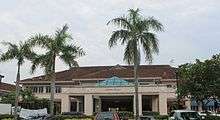
Malacca houses a number of government and private hospitals and health clinics, as well as hundreds of private clinics. The location of medical institutions are located all over the state of Malacca, either in urban or rural areas, providing uniform and equitable healthcare to the residents. Health-related affairs in Malacca is governed by Malacca State Health Department by providing basic health service to the residents and oversee all government health facilities in the state among hospitals, community polyclinic, rural health clinics and clinics.[91]
Malacca is also a popular place for health care and medical tourism for Indonesian people from Sumatra due to its close proximity to the state, followed by Singapore.[92][93] In 2014, Malacca received over 500,000 tourists for medical tourism-related purpose.[94]
Government hospitals in Malacca are Malacca General Hospital and Jasin District Hospital, while private hospitals are Putra Hospital, Pantai Hospital Ayer Keroh, Mahkota Medical Centre and Oriental Melaka Straits Medical Centre.
Energy and environment
Power generation
Malacca houses three power stations, namely the 330 MW Tanjung Kling Power Station in Tanjung Kling and 440 MW Telok Gong Power Station 1 and 720 MW Telok Gong Power Station 2 in Telok Gong, with a total installed generation capacity of 1,490 MW.[95]
Green energy
On 16 December 2013, the Malacca State Government unveiled the draft 8,000 hectares special area called the Malacca World Solar Valley in Rembia, Alor Gajah applying solar energy as the primary alternative in all municipal activity sectors.[96][97]
By 2020, the government-run 7,248ha Melaka World Solar Valley aims to power most of the daily activities of manufacturers, housing developers, farmers, and other stakeholders. Recently, a public-private partnership installed 100,000 LED street lamps along the Alor Gajah–Central Melaka–Jasin (AMJ) highway, which will improve road safety and reduce carbon dioxide emissions.[98]
Water supply
Water supply-related matters in Malacca is administered by the Malacca Water Company Ltd. (Malay: Syarikat Air Melaka Berhad) which is headquartered at Malacca City. It was established on 1 July 2006 after it was upgraded from its predecessor Malacca Water Corporation (Malay: Perbadanan Air Melaka). The company is also responsible for the maintenance and delivery infrastructure of clean water in the state.[99]
Currently, there are three dams located in Malacca supplying its residents with water, which are Durian Tunggal Dam in Alor Gajah, Jus Dam and Asahan Dam in Jasin. The fourth dam, Jernih Dam, will be constructed in Taboh Naning in Alor Gajah and expected to be completed by 2018.[100] There are three major retention basins in the state, which are Kesang Satu Lake, Kesang Dua Lake and Ayer Keroh Lake. Raw water is supplied from the Malacca River, Kesang River and Gerisik River.[101]
Daily water consumption for Malacca is 500 million litres and each resident consumes 220 litres per day, higher than the national average of 180 litres per day. The Malacca State Government signed an agreement with Johor State Government on a water supply agreement in 1993 and additional water supply agreement in 2013.[102][103] Another water supply agreement is planned to be signed with Negeri Sembilan in the future.[104]
Environmental campaign
Malacca adopted a campaign slogan of Don't Mess with Malacca since 2014 to reduce littering in the state after the local authorities found that cleanliness levels had dropped. The slogan was adopted from the Don't Mess with Texas campaign held in Texas, United States, launched in 1986. The idea came from Chief Minister Idris Haron when he was still studying at the University of Texas at El Paso in the late 1980s.[105]
Tourism


Tourism is a booming industry in Malacca. It is a popular travel destinations for Singaporeans during the weekends. Malacca has adopted as its slogan, "Visiting Malacca Means Visiting Malaysia" ("Melawat Melaka Bererti Melawati Malaysia"). There is a tourist map provided by Malacca.[106][107]
In 2017, the state recorded 16.79 million tourist arrivals, the highest number to date. Despite been a small state spanning 1,644 km2, Melaka has been a destination of choice for travellers from China, Singapore, Indonesia, Taiwan and Hong Kong.[108] During the first six months (January–June) 2018, over 8.73 million tourists were recorded visiting Melaka which is over seven percent compared to 8.14 million tourists for the first six months of 2017. It showed an increase of 599,037 tourists. The increase was contributed by the increase of domestic tourists to Melaka which was more than 72,000 or 1.36 percent. For domestic tourists, five states reportedly visited the most are from Selangor, Kuala Lumpur, Johor, Terengganu and Negeri Sembilan. Most of these tourists love to enjoy grilled fish and asam pedas in Malacca. In addition, foreign tourist arrivals also experienced a sharp increase of more than 520,000 or 19.03 percent. Travellers from five countries recorded the highest rates are China, Singapore, Indonesia, South Korea and Vietnam.[109]
In recent years, Malacca has received numerous international accolades. The city has been listed by several publications, including Forbes and Lonely Planet, as one of Asia's and World's Top Travel Destinations.[110][111] Malacca listed as one of 10 Best Destinations in Malaysia by Tripadvisor.[112] Waze App recognized Malacca with 'The Best City to Drive In' Award.[108] Globally, the historic city is ranked ahead of other major metros like Sydney, Lisbon, and Barcelona.[113] The city also has been recognised by HuffPost as 15 of the Best Street Art Cities.[114] In addition, Time publication placed Malacca as one of the best places to live and retire.[115]
Street art
Penang started the street art trend in Malaysia and Malacca soon followed suit with their River Art Project in 2012. Water has always been a big part of Malacca’s history. It was once one of the world’s most important trading ports, so it also makes sense that Malacca start the street art with the buildings beside the river. To boost the art landscape in Malacca, nine artists came together to paint their works on the walls of historical shophouses along the river in Jalan Kampung Hulu. Known as ProjectARM, these artworks are designed to highlight the beauty of Malacca. The murals depict the artists representation of Malacca and include a colourful mosaic painted on the walls of Kiehl’s store.[116][117]
Tourist attractions
Malacca has numerous historical places and buildings. In order to preserve those sites, numerous museums have been built to preserve those legacies. Most of the museums in the state are managed by Malacca Museum Corporation (PERZIM; Malay: Perbadanan Muzium Melaka).[118] Museums in Malacca are Aborigines Museum, Agricultural Museum, Malacca Al-Quran Museum, Baba Nyonya Heritage Museum, Beauty Museum, Cheng Ho Cultural Museum, Chitty Museum, Customs Department Museum, Democratic Government Museum, Education Museum, Malacca Forestry Museum, Governor's Museum, History and Ethnography Museum, Malacca Islamic Museum, Malacca Kite Museum, Malacca Literature Museum, Malacca Sultanate Palace Museum, Malay and Islamic World Museum, Malaysia Architecture Museum, Maritime Museum, Navy Museum, People's Museum, Prison Museum, Pulau Besar Museum, Stamp Museum, Straits Chinese Jewellery Museum, Submarine Museum, Toy Museum, Tradition and Custom Museum, UMNO Museum, World's Bees Museum and Youth Museum.
The other historical buildings and structures are A Famosa, Alor Gajah British Graveyard, Bastion Middleburg, Dutch Graveyard, Hang Jebat Mausoleum, Hang Kasturi Mausoleum, Hang Li Poh's Well, Hang Tuah Mausoleum, Hang Tuah's Well, Malacca Light, Malacca Warrior Monument, Portuguese Well, Proclamation of Independence Memorial, Ruins of Saint Paul's Church, Saint John's Fort, Stadthuys, Tun Abdul Ghafar Baba Memorial and Tun Teja Mausoleum.
There are also galleries displaying various aspects of life in Malacca, which include, Chief Minister’s Gallery, Demang Abdul Ghani Gallery, Folks Art Gallery, Malacca Gallery, Gallery of Admiral Cheng Ho, Macau Gallery, Malacca Art Gallery and Malacca House.
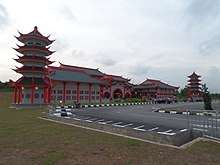
Theme parks, education centres, resorts and zoos in Malacca are A' Famosa Resort, Al-Khawarizmi Astronomy Complex, Malacca Bird Park, Malacca Butterfly and Reptile Sanctuary, Malacca Crocodile Farm, Malacca Planetarium, Malacca Wonderland, Malacca Zoo, Mini Malaysia and ASEAN Cultural Park, Pirate Park and Taming Sari Tower.
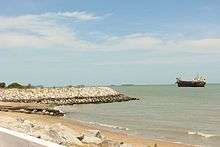
Malacca has natural-related tourist sites, such as Ayer Keroh Lake, Bukit Batu Lebah Recreational Forest, Cape Rachado, Garden of Thousand Flowers, Klebang Beach, Malacca Botanical Garden, Malacca River, Malacca Tropical Fruit Farm, Paya Laut Linggi Recreational Forest, Pengkalan Balak Beach, Puteri Beach, Saint Paul's Hill and Sungai Udang Recreational Forest. Malacca has also hot springs, namely Gadek Hot Spring and Jasin Hot Spring.
Malacca is a multi-religious society, therefore various worshiping places can be found around the state, namely Cheng Hoon Teng Temple, Chinese Mosque, Christ Church, Kampung Hulu Mosque, Kampung Kling Mosque, Poh San Teng Temple, Xiang Lin Si Temple, Saint Francis Xavier Church, Saint Peter's Church, Straits Mosque, Sri Poyatha Moorthi Temple, State Mosque and Tranquerah Mosque.
Public squares in Malacca are 1Malaysia Square, Alor Gajah Square, Ayer Keroh Square and Jasin Square.
Some night markets can be found along Jonker Walk in Chinatown during weekends evening and along Puteri Beach in Tanjung Kling. In total, there are around 87 night markets around Malacca.[119] During the Islamic fasting month, special night markets are opened along many major roads throughout the month.[120]
International relations
Cultural exchanges
China
In June 2012, the Macau Gallery Malacca was opened at Peringgit, Malacca under the government of Macau. In April 2015, the Malacca State Government decided to build the MYR300 million Malacca Information Centre which will be located in Zhuhai, Guangdong.[121]
Indonesia
In February 2013, the Malacca Gallery in Jakarta, Indonesia was officiated by Jakarta Governor Joko Widodo and Malacca Chief Minister Mohd Ali Rustam.[122][123][124][125]
Twin towns and friendship cities
Malacca first started twinning in 1984 with the city of Lisbon, Portugal and it is now twinned with or established as a friendship city with the following cities:[126][127]
| No. | Sister Cities | Country | Year |
|---|---|---|---|
| 1 | Lisbon[128][129][130][131] | 1984 | |
| 2 | Kuala Lumpur[132][133] | 1989 | |
| 3 | Hoorn[132][129][134] | 1989 | |
| 4 | Valparaíso[135][136][137] | 1991 | |
| 5 | Nanjing[138][139] in Jiangsu Province[140][141][139] | 2002 | |
| 6 | Changsha[142][143] | 2004 | |
| 7 | Sawahlunto[143][144] | 2004 | |
| 8 | Padang Panjang[143][145] | 2006 | |
| 9 | Kota Tua Jakarta[146][147] | 2014 | |
| 10 | Guangdong[148][149] | 2015 |
Transportation
Air
Malacca International Airport (IATA: MKZ, ICAO: WMKM) (formerly known as Batu Berendam Airport) is an airport located in Batu Berendam, Malacca, Malaysia. The airport serves the state of Malacca, as well as northern Johor, with links to Pekanbaru[150] and Penang[150]
Railway
There are currently two Keretapi Tanah Melayu railway stations in Malacca, which are the Pulau Sebang/Tampin Station in Pulau Sebang, Alor Gajah and Batang Malacca Station in Batang Malacca, Jasin.
There were railway tracks from Pulau Sebang to Malacca City before World War II, but these were dismantled by the Japanese for the construction of the Burmese Death Railway.[151] On October 10, 2015, Keretapi Tanah Melayu Berhad (KTMB) commuter service has introduced a new route, shuttle service between Seremban-Sebang/Tampin-Gemas station.[152][153]
A 1.6-km line of Malacca Monorail was launched in October 2010, served the route along the Malacca River. Due to several technical glitches months into its operation, the system was left idle in 2013. However, in June 2015 the Malacca State Government decided to revive the project.[154] On December 4, 2017, Malacca Monorail has re-operate[155] with enhanced safety features such as lightning-prevention devices and the addition of a rescue vehicle to attract wagons in the event of a technical problem.[156] The previous incident is believed will not recur as tests had been performed for two months before re-operation. The Malacca Monorail operating hours are 10.00 am to 10.00 pm on weekdays and will be continued until 12.00 midnight on Saturdays and Sundays.[157]
Water
Daily ferries run from Malacca to the Indonesian cities of Bengkalis, Dumai and Pekanbaru departing from Harbour Master's Jetty.[158] Regular boat services to Big Island depart from mainland Malacca in Umbai. Several jetties around the state, such as in Merlimau, are used by fishermen.[159]
Two existing container ports in Malacca are the Port of Kuala Sungai Linggi and Port of Tanjung Bruas.[160]
Road
Travelling to Melaka by bus is favored by most people. This is because Melaka is well connected to the PLUS highway via three major exits. The Ayer Keroh exit at the North–South Expressway is the main entry to Malacca, connected by Ayer Keroh highway to Malacca City. There are two additional exits along the North–South Expressway, namely the Simpang Ampat and Jasin exits. The Syed Abdullah Aziz Road or Malacca Coastal Highway roughly connects the western and eastern sides of Malacca separated by the Malacca River through the Malacca Coastal Bridge. It is also easy to access Melaka by bus because Melaka have 3 main bus hubs such as Melaka Sentral, Alor Gajah Sentral and Jasin Sentral. The location of the bus stations are based on their districts, Central Melaka, Alor Gajah and Jasin.[161] The Malacca Sentral bus station, combined with taxi terminal, serves cities around Peninsular Malaysia and Singapore.[162] The Panorama Malacca bus is the public bus that covered almost entire routes in Melaka from historical place, the shopping mall, and to the hotels.[163]
Efforts are also being undertaken to promote pedestrianisation and the use of bicycles as an environmentally friendly mode of transportation.[164][165] Dedicated bicycle lanes are being built on several main roads in this historic city.[166]
Many of the heavily decorated cycle rickshaws (Malay: beca) equipped with sound system can be seen on the streets in Malacca. Most of them are used to bring tourist around the town for sightseeing. The average size can accommodate two average adult with probably a child.[167]
Art of culture and entertainment
Melaka is an ideal filming location for domestic and international film production companies with the presence of various tourist attractions and historical remains. Iconic Bollywood artist, Shah Rukh Khan described Melaka as beautiful and said he would return for acting and holiday in the state.[168] The films and the music videos published in Malacca include:
- 1987 - Tragic Hero, starring Andy Lau. Part of this Hong Kong movie was filmed in Malacca.[169]
- 1999 - Entrapment, starring Sean Connery, Catherine Zeta-Jones and Kee Thuan Chye, Malaysian actor. Part of the Hollywood movie was shot at Malacca River.[170]
- 2001 - One 2 Ka 4, starring Shah Rukh Khan, Juhi Chawla and Jackie Shroff.[171]
- 2008 - Singaporean drama series The Little Nyonya, starring Jeanette Aw and Qi Yuwu.[172]
- 2011 - Don 2, starring Shah Rukh Khan and Priyanka Chopra. Malacca Prison were among the filming set of the Bollywood movie.[173]
- 2013 - Suami Aku Ustaz, starring Ady Putra, Nora Danish and Izzue Islam. The filming is fully carried out at several locations in Malacca.[174]
- 2016 - Kabali, starring Rajinikanth. Melaka Contingent Police Headquarters, Sungai Udang Prison and somewhere around Melaka towns were among the filming sites of the Kollywood movie.[175]
- 2016 - Ayda Jebat's Pencuri Hati music video (dangdut version).[176]
- 2017 - Malaysian drama series Hikayat Cinta Si Pematah Hati, starring Alif Satar.[177]
- 2018 - Malaysian telemovie Aku Nazmi starring Jay Iswazir, Ayda Jebat and Sheila Rusly[178]
- 2018 - Malaysian drama series Mr. Grey, starring Fendi Bakry.[179]
Notable people
- Experts and Academicians
- Shirley Geok-lin Lim, award-winning novelist, writer and Professor of English at the University of California, Santa Barbara.
- Suhaimi Sulaiman, news anchor and experienced media strategist in Malaysia.
- Tan Sri Dato' Sri Ahmad Maarop, seventh and current President of the Court of Appeal of Malaysia.
- Film, Television and Music
- Amar Asyraf, actor.
- Anuar Zain, singer and a multi award-winning artist.
- Aubrey Suwito, Malaysian pianist, keyboardist, songwriter, arranger and producer.
- Christopher Lee, actor.
- Remy Ishak, actor.
- Resh (Malaysian singer) or Reshmonu, singer-songwriter.
- Ziana Zain, pop singer-songwriter, model, entrepreneur and actress
- History
- Dol Said, 19th-century Malay leader of an area called Naning, which was then part of Malacca on the Malay Peninsula.
- Ee Tiang Hong, Malayan poet of Chinese ancestry.
- Hang Jebat, closest companion of the legendary Malaccan hero Hang Tuah.
- Hang Li Po, fifth wife of Malaccan Sultan Mansur Shah (reigned 1456-1477).
- Hang Nadim, very young Malay boy of great ingenuity who saved Temasek, now called Singapore, from attack by shoals of a species of swordfish named todak; attacks which cost many indigenous Malays their lives.
- Hang Tuah, legendary warrior who lived in Malacca during the reign of Sultan Mansur Shah in the 15th century.
- Munshi Abdullah (Abdullah Abdul Kadir), Malayan writer, was a Malacca-born Indian munshi of Singapore and died in Jeddah, a part of the Ottoman Empire.
- Panglima Awang (Enrique of Malacca), native of the Malay Archipelago who participated in the Portuguese explorer Ferdinand Magellan's mission in the 16th century to sail around the world.[180][181]
- Tan Sri Hajjah Zainon Munshi Sulaiman, historic Malaysian politician, teacher and an independence campaigner.
- Tun Dato' Sri Tan Cheng Lock, (one of the founding fathers of modern Malaysia and the founder of the Malaysian Chinese Association).
- Tun Ali of Malacca, fourth bendahara, or prime minister of the Malaccan Sultanate.
- Tun Perak, fifth bendahara, a Malay rank similar to a prime minister, of the Sultanate of Malacca.
- Tun Perpatih Putih, sixth bendahara of the Sultanate of Malacca.
- Tun Mutahir of Malacca, bendahara of the Malaccan Sultanate.
- Tun Fatimah, well-known Malaysian heroine and daughter of Tun Mutahir the Malaccan bendahara who lived during the 16th century.
- Politics
- Betty Chew, wife to Lim Guan Eng, former Minister of Finance of Malaysia (2018-2020).
- Chua Tian Chang, Malaysian politician and was the former Member of Parliament for the Batu constituency in Kuala Lumpur, Malaysia from March 2008 to May 2018.
- Dato' Seri Liow Tiong Lai, former Minister of Transport of Malaysia (2014-2018) and Minister of Health (2008-2013).
- Datuk Wira Haji Ahmad Hamzah, Malaysian politician and is the Member of the Parliament of Malaysia for the Jasin constituency in the State of Melaka.
- Devan Nair, Melaka-born third President of Singapore and appointed by Parliament on October 23, 1981.
- Goh Leong San, Malaysian politician.
- Kerk Kim Hock, Malaysian politician and the fourth secretary-general for the Democratic Action Party (DAP).
- Koh Nai Kwong, Malaysian politician of the Malaysian Chinese Association (MCA).
- Lai Meng Chong, Malaysian politician from the town of Machap Baru in Malacca state.
- Mas Ermieyati Samsudin, independent member of parliament.
- Md Sirat Abu, Malaysian politician and a former Member of the Parliament of Malaysia for the Bukit Katil constituency in the state of Melaka.
- Shamsul Iskandar Md. Akin, Malaysian politician.
- Tan Siew Sin, son of Tun Dato' Sri Tan Cheng Lock, Malaya's (later Malaysia's) first Minister of Commerce and Industry, Finance Minister for 15 years, and third president of the Malayan Chinese Association (MCA, later Malaysian Chinese Association), a major component party of Alliance and later National Front (BN) coalition.
- Tan Sri Datuk Seri (DR.) Abu Seman Yusop, Member of the Parliament of Malaysia for the Masjid Tanah constituency in the state of Melaka from 2004 to 2013.
- Tun Abdullah Mohd Salleh, 5th Chief Secretary to the Government of Malaysia, serving as Chief Secretary from 1 October 1976 to 31 December 1978.
- Tan Sri Abdul Rahim Thamby Chik, Malacca Chief Minister (1982-1994).
- Datuk Seri Haji Mohd Zin Abdul Ghani, Malacca Chief Minister (1994-1997).
- Allahyarham YAB Datuk Seri Abu Zahar Ithnin, Malacca Chief Minister (1997-1999).
- Tan Sri Haji Mohd Ali Rustam, Malacca Chief Minister (1999-2013). Melaka River Cruise which is also known as Venice of the East[182][183] was inspired by him.[184][185] His contribution of ideas also in the construction of Melaka Straits Mosque[186][187] and Taming Sari Tower.[188]
- Datuk Seri Utama Ir. Haji Idris Haron, Malacca Chief Minister (2013-2018). He has been leading the project to redevelop Big Island starting with electricity supply to the Big Island and upgrading Sekolah Menengah Agama Dan Tahfiz Al-Quran Pulau Besar Melaka[189] In March 2018, Datuk Seri Utama Ir. Idris Haron has been awarded the Melaka State Sports Icon Award recipient.[190]
- Haji Adly Zahari, Malacca Chief Minister (2018-2020).
- Sports
- Amirul Hadi, Malaysian professional footballer who plays for Malaysian club Johor Darul Ta'zim II and the Malaysian national team as a central midfielder.
- Azman Adnan, former Malaysian footballer.
- Badrul Hisyam Abdul Manap, Malaysian competitive runner.
- Ching Hong Aik, Malaysian former footballer.
- Datuk Rabuan Pit, former Asian sprint king.
- Dollah Salleh, former footballer and football coach.
- Elena Goh Ling Yin, Malaysian race walker.
- Farderin Kadir, Malaysian footballer who mainly plays as a striker but can also plays as an attacking midfielder for Melaka United.
- Goh Liu Ying, Malaysian professional badminton player.
- Goh Soon Huat, badminton player from Malaysia.
- Julia Wong Pei Xian, badminton player from Malaysia.
- Khairul Hafiz Jantan, Malaysian sprinter.
- Lim Teong Kim, retired Malaysian football player and formerly an assistant coach of Bayern Munich U-19 Team.
- Mirnawan Nawawi, former field hockey player.
- Mohd Suffian Abdul Rahman, Malaysian footballer currently playing as a goalkeeper for Terengganu FA.
- Mohizam Shah Dawood Shah, Malaysian former football player.
- Norhafiz Zamani Misbah, Malaysian professional footballer who plays as centre-back.
- Norizam Ali Hassan, Malaysian former footballer who played as striker.
- Ong Kim Swee, Malaysian football manager and former footballer.
- Robert Braddell, historic English cricketer.
- See Kok Luen, Malaysian footballer who currently plays for Melaka United FC in the 2020 Malaysia M3 League.[191]
- Shukor Adan, Malaysian footballer who is currently playing for Felda United and also serves as their captain.
- Soh Chin Aun, Malaysian national football player from Malacca alongside the late Mokhtar Dahari and R. Arumugam.
- YH Dato' Sri Mohamad Norza Zakaria, President of Olympic Council of Malaysia (OCM) and also hold the post of President of Commonwealth Games Association of Malaysia.
- Others
- Abdul Razak Mohd Yusof, police senior officer, martial artist and one of the national heroes from the Royal Malaysia Police 69 Commando of the Pasukan Gerakan Khas.
- A. Samad Said, novelist and poet.
- Danny Lim, Malaysian writer, journalist and photographer.
References
- "Melaka River - Malacca City Attractions". Malacca.ws. Retrieved 29 October 2012.
- "Laporan Kiraan Permulaan 2010". Jabatan Perangkaan Malaysia. p. 27. Retrieved 24 January 2011.
- "Population by States and Ethnic Group". Department of Information, Ministry of Communications and Multimedia, Malaysia. 2015. Archived from the original on 12 February 2016. Retrieved 12 February 2015.
- Headrick (2010), pp. 63
- "Melaka Jatuh Ke Tangan Belanda -". hids.arkib.gov.my. Archived from the original on 15 August 2018. Retrieved 15 August 2018.
- Mat Rofa Ismail (2015). Kerdipan Bintang Melayu Dilangit Turki. Alaf 21. ISBN 9789678604864 – via Google Books.
- Wong, John; Zou, Keyuan; Zeng, Huaqun, eds. (2006). China-ASEAN Relations: Economic and Legal Dimensions. Singapore: World Scientific. ISBN 9789814478618.
- "Signing of the Anglo-Dutch Treaty (Treaty of London) of 1824 - Singapore History". eresources.nlb.gov.sg.
- Singapore, National Library Board. "Malayan Campaign - Infopedia". eresources.nlb.gov.sg.
- "Info" (PDF). studentsrepo.um.edu.my.
- "Penubuhan Malayan Union -". hids.arkib.gov.my. Archived from the original on 15 August 2018. Retrieved 15 August 2018.
- "Federation of Malaya is inaugurated - Singapore History". eresources.nlb.gov.sg.
- "Official Portal of Malaysia National Archives". Arkib.gov.my. Archived from the original on 18 August 2018. Retrieved 18 August 2018.
- "Community Involvement for Sustainable World Heritage Sites: The Melaka Case" (PDF). web.usm.my. Archived from the original (PDF) on 2 December 2018.
- "Making Melaka liveable, resilient, and future-proof". Star2.com. Archived from the original on 18 November 2018. Retrieved 18 November 2018.
- https://theculturetrip.com/asia/malaysia/articles/malaysia-s-most-beautiful-places-to-visit-must-see-destinations/
- Suhaila Abdullah (2013). "Effect of Malay-China Trade Relations During the Malacca Sultanate on the Emergence of Chinese Peranakan Community" (PDF). World Journal of Islamic History and Civilization. 3 (4): 143–149.
- Ravichandran Moorthy (2009). "The Evolution of the Chitty Community of Melaka" (PDF). Jebat: Malaysian Journal of History, Politics & Strategic Studies. 36: 1–15.
- https://www.melaka.gov.my/en/citizen/melaka-info/culture
- "Eurasian community". Singapore Infopedia. 2013.
- Ricklefs (1993), p. 19
- Southeast Asia in the Ming Shi-lu: an open access resource, translated by Wade, Geoff, Singapore: Asia Research Institute and the Singapore E-Press, National University of Singapore, 2005
- "Know your Malacca tree". The Star Online. 29 July 2006. Retrieved 19 August 2018.
- Winstedt, R. O. (1922). "Two legends of Malacca". Journal of Straits Branch of Royal Asiatic Society. 85: 40.
- Adam, Ahmat (2019). Hikayat Raja-Raja Pasai. Petaling Jaya: SIRD. p. 71.
- Sen, Tansen (2016). "The Impact of Zheng He's Expeditions on Indian Ocean Interactions". Bulletin of the School of Oriental and African Studies. 79 (3): 615. doi:10.1017/S0041977X16001038.
- Wang, Gungwu (2005). "The First Three Rulers of Malacca". In Suryadinata, Leo (ed.). Admiral Zheng He & Southeast Asia. Singapore: International Zheng He Society. p. 40. ISBN 981-230-329-4.
- Sen, Tansen (2016). "The Impact of Zheng He's Expeditions on Indian Ocean Interactions". Bulletin of the School of Oriental and African Studies. 79 (3): 620–621. doi:10.1017/S0041977X16001038.CS1 maint: ref=harv (link).
- Jin, Shaoqing (2005). Office of the People's Government of Fujian Province (ed.). Zheng He's voyages down the western seas. Fujian, China: China Intercontinental Press. p. 58. ISBN 978-7-5085-0708-8. Retrieved 2 August 2009.
- Royal Asiatic Society of Great Britain and Ireland. Straits Branch, Reinhold Rost (1887). Miscellaneous papers relating to Indo-China: reprinted for the Straits Branch of the Royal Asiatic Society from Dalrymple's "Oriental Repertory," and the "Asiatic Researches" and "Journal" of the Asiatic Society of Bengal, Volume 1. London: Trübner & Co. p. 252. Retrieved 9 January 2011.
.
- Shih-shan Henry Tsai (1996). The eunuchs in the Ming dynasty (illustrated ed.). SUNY Press. p. 15. ISBN 0-7914-2687-4. Retrieved 28 June 2010.
Other reports condemned Annamese alleged violation of an Asian "diplomatic protocol" as they killed and enslaved several Southeast Asian envoys who carried tributary missions to China in 1469. Older members of the mission were all killed while younger members were castrated and sold into slavery
- Ricklefs (1993), p. 23
- Ricklefs (1993), pp. 23–24
- Borschberg (2015), pp. 65-74
- Borschberg (2010), pp. 157–158
- "Hari Ini Dalam Sejarah". www2.arkib.gov.my.
- "Elevation of Melaka, Malaysia Elevation Map, Topography, Contour". floodmap.net. Archived from the original on 16 March 2015.
- "Beautiful beaches and island in Malacca, Malaysia". melaka.net.
- "Malacca Weather". malacca.ws.
- "Malacca Climate Normals 1961–1990". National Oceanic and Atmospheric Administration. Retrieved 7 May 2014.
- "Melaka (Federal State, Malaysia) - Population Statistics and Location in Maps and Charts". citypopulation.de.
- Juli Paul. "Malacca business, the Malacca economy & the booming tourist industry". spy.my.
- "Melaka Refinery". petronas.com.my.
- "PETRONAS Penapisan (Melaka) Sdn Bhd". petronas.com.my.
- "Melaka International Trade Centre". Archived from the original on 1 July 2015. Retrieved 28 May 2015.
- "MELAKA MAJU 2010" [PROGRESSIVE MELAKA 2010]. 1KLIK (in Malay). Archived from the original on 18 November 2018. Retrieved 18 November 2018.
- "Rakyat iktiraf Melaka Maju 2010" [Malaysians recognize Progressive Malacca 2010]. Utusan ONLINE (in Malay). 18 November 2018. Archived from the original on 18 November 2018. Retrieved 28 July 2018.
- Super User. "Economy In Melaka". pknm.gov.my. Archived from the original on 22 June 2015.
- Super User. "E-MELAKA". emelaka.gov.my. Archived from the original on 4 July 2015.
- "Step up Malacca-China bilateral cooperation to boost economy". www.thesundaily.my. Bernama. 2 March 2015. Retrieved 6 May 2017.
- "Melaka expects RM5.4b in green technology investments by 2020". themalaymailonline.com.
- "Department of Statistics Malaysia Official Website". statistics.gov.my. Archived from the original on 15 June 2015.
- "Malaysia Millennium Development Goals Report 2015" (PDF). ECONOMIC PLANNING UNIT PRIME MINISTER'S DEPARTMENT MALAYSIA. Archived from the original (PDF) on 18 November 2018. Retrieved 18 November 2018.
- "Industrial Area". Archived from the original on 13 July 2015. Retrieved 26 May 2015.
- "The historic state and city : Melaka today". melaka.net.
- "Terengganu second safest place to live in after Malacca". NEW STRAITS TIMES. 27 November 2018. Archived from the original on 19 February 2016.
- "Kadar jenayah di Melaka turun 15.5 peratus" [Crime rates in Melaka fell by 15.5 percent]. Sinar ONLINE (in Malay). 18 November 2018. Archived from the original on 18 November 2018. Retrieved 18 November 2018.
- "Melaka posts second-highest GDP growth in Malaysia". FMT news. Archived from the original on 30 November 2018. Retrieved 30 November 2018.
- Mohd Uzir, M. (n.d.). Laporan Sosioekonomi Negeri 2017. Retrieved from Jabatan Perangkaan Malaysia website: https://www.dosm.gov.my/v1/index.php?r=column/pdfPrev&id=d21BMHFxZFBIcFlCNExIYUQ1cE92Zz09
- "Isu Tenaga Kerja Antara Fokus Exco Melaka G. Saminathan" [Manpower Issue Among Focus by Melaka Exco G. Saminathan]. Bernama.com (in Malay). 30 November 2018. Archived from the original on 30 November 2018.
- "Community In Melaka". melaka.gov.my.
- "Dondang Sayang". UNESCO. Archived from the original on 25 December 2018. Retrieved 25 December 2018.
- "Dondang Sayang terima pengiktirafan UNESCO" [Dondang Sayang receives UNESCO recognition] (in Malay). astro AWANI. Archived from the original on 25 December 2018. Retrieved 25 December 2018.
- "MELAKA BANDARAYA BERSEJARAH" [MELAKA HISTORIC CITY]. geocities (in Malay). Archived from the original on 2 July 2016. Retrieved 8 August 2020.
- "Top 50 World Street Food Masters" (PDF). world street food congress 2017. Archived (PDF) from the original on 18 November 2018. Retrieved 18 November 2018.
- "15 Malaccan Dishes You Should Try Before You Die". SAYS. Archived from the original on 18 November 2018. Retrieved 18 November 2018.
- "Fact & Number". melaka.gov.my. Archived from the original on 1 June 2015.
- "Kebudayaan — Bahasa Melayu" (in Malay). Melaka.gov.my. Retrieved 18 August 2018.
- "Malacca's most famous Malay village, Kampung Morten, is named after a british-era collector of land revenue". Malaysia Premier Property and Real Estate Portal.
- "Jonker Street in Malacca - Everything you need to know about Jonker Street". malacca.ws. Retrieved 20 February 2020.
- Kim, Khoo, Kay (18 August 1979). "Melaka dalam zaman moden". journalarticle.ukm.my.
- "Culture — English". Melaka.gov.my. Retrieved 18 August 2018.
- "Sikhs gather from all over the world to celebrate for four days - Community - The Star Online". www.thestar.com.my.
- In Joseph, C. (2018). Policies and politics in Malaysian education: Education reforms, nationalism and neoliberalism.
- Rizanizam, A. H. (1 January 2009). "Perkampungan Portugis jadi tarikan". Utusan Malaysia.
- "Travelling information one should know while in Malaysia". melaka.net.
- "2010 Population and Housing Census of Malaysia" (PDF). Department of Statistics, Malaysia. Archived from the original (PDF) on 22 May 2014. Retrieved 17 June 2012. p. 13
- "2010 Population and Housing Census of Malaysia" (PDF) (in Malay and English). Department of Statistics, Malaysia. p. 86. Archived from the original (PDF) on 16 January 2013. Retrieved 17 June 2012.
- Harding, Andrew (27 July 2012). "Chapter 8 - Religion and the Constitution". The Constitution of Malaysia: A Contextual Analysis. Hart Publishing. ISBN 9781847319838.
- "Melaka State Sports Council (MSNM)". melaka.gov.my.
- Super User. "Hang Tuah Stadium". stadiummelaka.gov.my. Archived from the original on 5 April 2015.
- Super User. "Profile". stadiummelaka.gov.my. Archived from the original on 26 June 2015.
- "Melaka International Bowling Centre". Hang Tuah Jaya Municipal Council. Archived from the original on 2 June 2015.
- Golfasian (16 December 2013). "Golf Courses in Malacca". malaysiagolfholiday.com.
- https://www.malaysia.gov.my/public/dservice/education.html
- https://moe.gov.my/index.php/en/soal-selidik/183-murid-pelajar/sekolah/1574-sekolah-berpretasi-tinggi
- "Bapa lega dapat bantuan TAPEM, MAIM" [Father relieved after TAPEM, MAIM help]. Harian Metro (in Malay). 20 November 2018. Archived from the original on 15 August 2018.
- "Tabung Amanah Pendidikan Negeri Melaka — English". Melaka.gov.my. Retrieved 18 August 2018.
- Super User. "Chronology". perpustam.gov.my.
- "Health". melaka.gov.my.
- "Melaka International Airport". AmazingMelaka.com. Archived from the original on 13 June 2015.
- "Muzium Melaka akan dibina di China". sinarharian.com.my. 19 March 2015.
- "Malacca medical tourism hits over 500,000 tourists seeking treatments - Community - The Star Online". thestar.com.my.
- Administrator. "Company Profile - Powertek Berhad Group". powertek.com.my. Archived from the original on 27 May 2015. Retrieved 27 May 2015.
- "Malacca unveils draft plan for solar valley". themalaymailonline.com.
- Super User. "Melaka World Solar Valley". melakagreentech.gov.my.
- https://www.nst.com.my/node/416836/amp
- Super User. "Latar Belakang". samb.com.my.
- "RM190m Jernih Dam scheduled to be completed by 2018". thesundaily.my.
- "Mengambil iktibar daripada pengurusan air Melaka". themalaysianinsider.com. Archived from the original on 19 September 2015.
- Star Media Group Berhad. "Malacca to start water rationing after Mar 29 if dry spell continues - Nation - The Star Online". thestar.com.my.
- "Learning efficient water supply management from Malacca". The Rakyat Post.
- khalid. "RM190 Million Jernih Dam Scheduled To Be Completed By 2018". MyNewsHub. Archived from the original on 17 June 2015. Retrieved 17 June 2015.
- "Understand the 'Don't mess with Melaka' campaign". thesundaily.my.
- "Melaka State Map" (PDF). www.melaka.gov.my.
- "Melaka Town Map" (PDF). www.melaka.gov.my.
- "MELAKA". New Straits Times. Archived from the original on 14 August 2018. Retrieved 18 November 2018.
- "Melaka catat kedatangan lebih 8.73 juta pelancong" [Melaka recorded more than 8.73 million visitors] (in Malay). astro AWANI. Archived from the original on 20 November 2018. Retrieved 20 November 2018.
- "The 10 Coolest Cities Around the World to Visit in 2018". Forbes. Archived from the original on 22 February 2018. Retrieved 18 November 2018.
- "Lonely Planet's Best in Asia 2017". lonely planet. Archived from the original on 18 November 2018. Retrieved 18 November 2018.
- "Top 10 Destinations — Malaysia". tripadvisor MALAYSIA. Archived from the original on 18 November 2018. Retrieved 18 November 2018.
- "Waze Says This Historic City Is The Best Place To Drive In Malaysia". SAYS. Archived from the original on 18 November 2018. Retrieved 18 November 2018.
- "15 of the Best Street Art Cities -- an Alternative List". LIFE. Archived from the original on 18 November 2018. Retrieved 18 November 2018.
- "4 Under-the-Radar Countries Where You Can Retire for Cheap". Money. Archived from the original on 20 February 2018. Retrieved 18 November 2018.
- "Street Art in Malacca (Melaka)". the Culture Map. Archived from the original on 29 November 2018. Retrieved 29 November 2018.
- "The Best Mural Artworks in Malaysia". culture trip. Archived from the original on 29 November 2018. Retrieved 29 November 2018.
- "PERZIM - Background of PERZIM". PERZIM.
- Super User. "NIGHT MARKET". emelaka.gov.my. Archived from the original on 4 July 2015.
- "Tahun ini terlalu mahal". HM Online.
- "Melaka information centre will be developed in China, says Idris Haron - Business News - The Star Online". thestar.com.my.
- "Perasmian Galeri Melaka". dmdi.com.my. Archived from the original on 14 June 2015.
- Al Amin (22 February 2013). "Ada Galeri Melaka, Jokowi harap turis Malaysia banjiri Jakarta". merdeka.com.
- "Malaysia Dirikan Galeri Kebudayaan di Jakarta - Tempo Metro". Tempo.
- Kompas Cyber Media. "Melawat Melaka Lewat Galeri Melaka". KOMPAS.com.
- "At A Glance [TwinCities 2017]". Melaka Historic City Council. Archived from the original on 31 December 2017. Retrieved 28 July 2018.
- "MBMB MUO With Twin Cities". Melaka Historic City Council. Archived from the original on 17 September 2017. Retrieved 28 July 2018.
- "Acordos de Geminação, de Cooperação e/ou Amizade da Cidade de Lisboa" [Lisbon - Twinning Agreements, Cooperation and Friendship]. Camara Municipal de Lisboa (in Portuguese). Archived from the original on 31 October 2013. Retrieved 23 August 2013.
- "New Sunday Times - Google News Archive Search". news.google.com.
- "Consulta". www.anmp.pt.
- "Wayback Machine" (PDF). 25 September 2015. Archived from the original (PDF) on 25 September 2015.
- "News" (PDF). library.perdana.org.my. 1992. Archived from the original (PDF) on 25 September 2015. Retrieved 2 August 2018.
- "Twincities". msdesk.mbmb.gov.my.
- "MDDP - In the Press =- Malacca, a Dutch conquest forgotten". 25 September 2015. Archived from the original on 25 September 2015.
- Marina Tan (9 January 1998). "Valpairaso, land of steep hills, trains, sea and curves". New Straits Times. Retrieved 25 September 2015.
- "Portal - Anniversary of the twinning of the Cities of Melaka and Valparaiso - Year 2007". Kln.gov.my. Archived from the original on 3 August 2018. Retrieved 18 August 2018.
- "Portal - Melaka is keen to get Valparaiso's help - Year 2007". www.kln.gov.my.
- "Penerbangan khas Nanjing-Melaka guna LTAM". Utusan Online. Archived from the original on 3 August 2018. Retrieved 3 August 2018.
- "PressReader.com - Connecting People Through News". www.pressreader.com.
- Jiangsu. (2017). Retrieved from Jiangsu Provincial People's Government website: http://en.jiangsu.gov.cn/col/col54176/index.html?yqpgnm=msjgy3
- "Melaka jalin hubungan dengan wilayah Jiangsu". Utusan Online.
- Government, Hunan. "Hunan Government Website International-enghunan.gov.cn". www.enghunan.gov.cn.
- kamarul (11 May 2016). "MBMB MUO With Twin Cities".
- wiguna, surya. "sawahlunto malaka". Cite journal requires
|journal=(help) - "Twincities". 31 December 2017. Archived from the original on 31 December 2017.
- Edna Tarigan (2 January 2014). "Jakarta's 'Kota Tua' and Melaka are now sister cities". The Jakarta Post. The Jakarta Post Travel. Archived from the original on 6 February 2014. Retrieved 25 September 2015.
- "Melaka, Kembaran Kota Tua Jakarta di Malaysia".
- Chan (23 September 2015). "Guangdong & Malacca sign sister relationship memo". News Guangdong. Archived from the original on 25 September 2015. Retrieved 25 September 2015.
- "Document" (PDF). www.kln.gov.my. Archived from the original (PDF) on 3 August 2018. Retrieved 2 August 2018.
- "Melaka mahu buka semula laluan penerbangan domestik, antarabangsa di LTAM - Astro Awani". www.astroawani.com.
- Nor Shahid, M. N. (2015, July 24). We can revive Tampin-Malacca rail service. New Straits Times. Retrieved from https://www.nst.com.my/news/2015/09/we-can-revive-tampin-malacca-rail-service
- KTMB perkenal perkhidmatan komuter baharu dari Seremban ke Gemas. (2015, October 1). Berita Harian. Retrieved from https://www.bharian.com.my/node/85731
- "Komuter guna jadual baru mulai esok". 2 February 2018.
- "Malacca wants to revive monorail line to promote river". AsiaOne.
- "Lebih 17,000 guna Monorel Melaka sejak beroperasi semula". Utusan Borneo Online. 3 February 2018.
- "Kos taman tema, naik taraf kawasan monorel Melaka RM109 juta - Astro Awani". www.astroawani.com.
- "Monorel Melaka beroperasi semula esok - The Malaysian Insight". www.themalaysianinsight.com.
- "Ferries to Malaysia-ferries from Indonesia". Tourist Attractions in Malaysia. Archived from the original on 13 June 2015. Retrieved 12 May 2015.
- "Malaysia Truly Asia - Tourism Travel Information Guide: Merlimau Pantai Jetty - Jetty Nelayan Merlimau Pantai". songketmail.org.
- "Longer runway and international port for Malacca". Free Malaysia Today. Archived from the original on 22 June 2015. Retrieved 22 June 2015.
- "Getting to Melaka: By Bus". MelakaCool. Archived from the original on 3 June 2019. Retrieved 8 August 2020.
- "Melaka Sentral". ExpressBusMalaysia.com.
- "Routes & Schedules - Panorama Melaka". panoramamelaka.com.my.
- "Making Melaka Resilient". TheStar. 9 August 2020. Archived from the original on 9 August 2020.
- "Motif kuda belang di lintasan pejalan kaki Melaka" [The motif of a zebra at the Melaka pedestrian crossing]. BHOnline (in Malay). 9 August 2020. Archived from the original on 9 August 2020.
- "Riding a green wave in Malacca". TheStar. 9 August 2020. Archived from the original on 9 August 2020.
- "Trishaw or Beca rides in Malacca town". yinteing.com.
- "Malaysia syurga penggambaran" [Malaysia is paradise of filming]. Kosmo! Online (in Malay). 19 November 2018. Archived from the original on 28 July 2018.
- "Tragic Hero (1987)". RETRO JUNK. Archived from the original on 19 November 2018. Retrieved 19 November 2018.
- "7 Hollywood Movies Filmed in Malaysia". ExpatGo. Archived from the original on 19 November 2018. Retrieved 19 November 2018.
- "Shah Rukh Khan terima pingat Datuk" [Shah Rukh Khan accepts Datukship]. Kosmo! Online (in Malay). 19 November 2018. Archived from the original on 19 November 2018.
- "Big Little Nyonya". THE Star ONLINE. 19 November 2018. Archived from the original on 19 November 2018.
- "10 Movies You Didn't Know Were Filmed In Malaysia. Spot The Bas Sekolah!". SAYS. Archived from the original on 19 November 2018. Retrieved 19 November 2018.
- "Nora Danish: 'Suami aku ustaz'" [My husband is an ustaz]. Sinar ONLINE (in Malay). 19 November 2018. Archived from the original on 19 November 2018.
- "Exco Melaka, wartawan teruja jumpa sendiri Rajinikanth" [Melaka exco, journalist excitedly met Rajinikanth himself]. PROJEK mm (in Malay). Archived from the original on 19 November 2018. Retrieved 19 November 2018.
- "Ayda Jebat Tampil Dengan Telefon Edisi Istimewa" [Ayda Jebat Appear With Special Edition Phone]. COSMOPOLITAN (in Malay). Archived from the original on 19 November 2018. Retrieved 19 November 2018.
- "Memang penat tapi berbaloi" [It is tiring but worth it]. Harian Metro (in Malay). 19 November 2018. Archived from the original on 14 September 2018.
- "Belajar Bahasa Isyarat, Ayda Jebat Menangis" [Learn Sign Language, Ayda Jebat Cries]. GEMPAK (in Malay). Archived from the original on 19 November 2018. Retrieved 19 November 2018.
- "Fendy berubat kampung sakit misteri" [Fendy use traditional medicine to treat his mystery illness]. my Metro (in Malay). 19 November 2018. Archived from the original on 25 April 2018.
- Singapore, National Library Board. "Purbawara Panglima Awang - BookSG - National Library Board, Singapore". eresources.nlb.gov.sg. Retrieved 30 July 2018.
- Nasron Sira, R. (2015, May 18). SIRI MISTERI: 'Panglima Awang' Melayu pertama keliling dunia. Berita Harian. Retrieved from https://www.bharian.com.my/node/55556
- "Melaka's appeal lies in its colourful past". AsiaOne. Retrieved 27 July 2018.
- "Sungai Melaka ibarat Venice of The East". Utusan Online. Retrieved 27 July 2018.
- "MELAKA RIVER CRUISE". www.ppspm.gov.my. Retrieved 27 July 2018.
- "Sg Melaka — money spinner for heritage city". BorneoPost Online | Borneo , Malaysia, Sarawak Daily News. 2 October 2010. Retrieved 27 July 2018.
- "Masjid Selat Melaka (Malacca Straits Mosque)". Islamic Tourism Centre. Retrieved 28 July 2018.
- Bakar, Suffian Abu. "Masjid Selat Melaka tumpuan pelancong" [Malacca Strait Mosque is a tourist attraction]. Utusan Online (in Malay). Archived from the original on 21 November 2018. Retrieved 28 July 2018.
- Jimadie Shah Othman (4 November 2008). "Rosak: Taming Sari jawab PAS" (in Malay). Retrieved 28 July 2018.
- Bakar, Suffian Abu. "Penduduk Pulau Besar terima manfaat" [The people of the Big Island benefit]. Utusan Online (in Malay). Archived from the original on 7 August 2018. Retrieved 7 August 2018.
- "Datuk Seri Utama Ir. Idris Haron Dinobat Ikon Pembangunan Sukan Negeri Melaka".
- "Senarai Pemain Melaka United FC 2020". Football Association of Malaysia.
Sources
- Borschberg, Peter (2002). "The Seizure of the Sta. Catarina Revisited: The Portuguese Empire in Asia, VOC Politics and the Origins of the Dutch-Johor Alliance (1602 – c. 1616)". Journal of Southeast Asian Studies. 33 (1): 31–62. doi:10.1017/S0022463402000024. JSTOR 20072387.
- Borschberg, Peter, ed. (2004). Iberians in the Singapore-Melaka Area and Adjacent Regions (16th to 18th Centuries). South China and Maritime Asia 14. Germany: Harrassowitz. ISBN 3-447-05107-8. https://www.academia.edu/4302755
- Borschberg, Peter (2010). The Singapore and Melaka Straits. Violence, Security and Diplomacy in the Seventeenth Century. Singapore: NUS Press. ISBN 978-9971-69-464-7.CS1 maint: ref=harv (link) https://www.academia.edu/4302722
- Borschberg, Peter, ed. (2015). Journal, Memorial and Letters of Admiral Cornelis Matelieff de Jonge. Security, Diplomacy and Commerce in 17th Century Southeast Asia. Singapore: NUS Press. ISBN 978-9971-69-798-3.CS1 maint: ref=harv (link) https://www.academia.edu/4302783
- Borschberg, Peter (2017). "The Value of Admiral Matelieff's Writings for Studying the History of Southeast Asia, c. 1600–1620". Journal of Southeast Asian Studies. 48 (3): 414–435. doi:10.1017/S002246341700056X.
- De Witt, Dennis (2010). Melaka from the Top. Malaysia: Nutmeg Publishing. ISBN 978-983-43519-2-2.
- De Witt, Dennis (2007). History of the Dutch in Malaysia. Malaysia: Nutmeg Publishing. ISBN 978-983-43519-0-8.
- Ricklefs, M.C. (1993). A History of Modern Indonesia Since c.1300 (2nd ed.). London: MacMillan. ISBN 0-333-57689-6.CS1 maint: ref=harv (link)
- Headrick, Daniel R. (2010). Power Over Peoples: Technology, Environments, and Western Imperialism, 1400 to the present. Princeton: Princeton University Press.CS1 maint: ref=harv (link)
- "Popular History of Thailand" by M.L. Manich Jumsai, C.B.E., M.A.


External links
![]()
![]()
